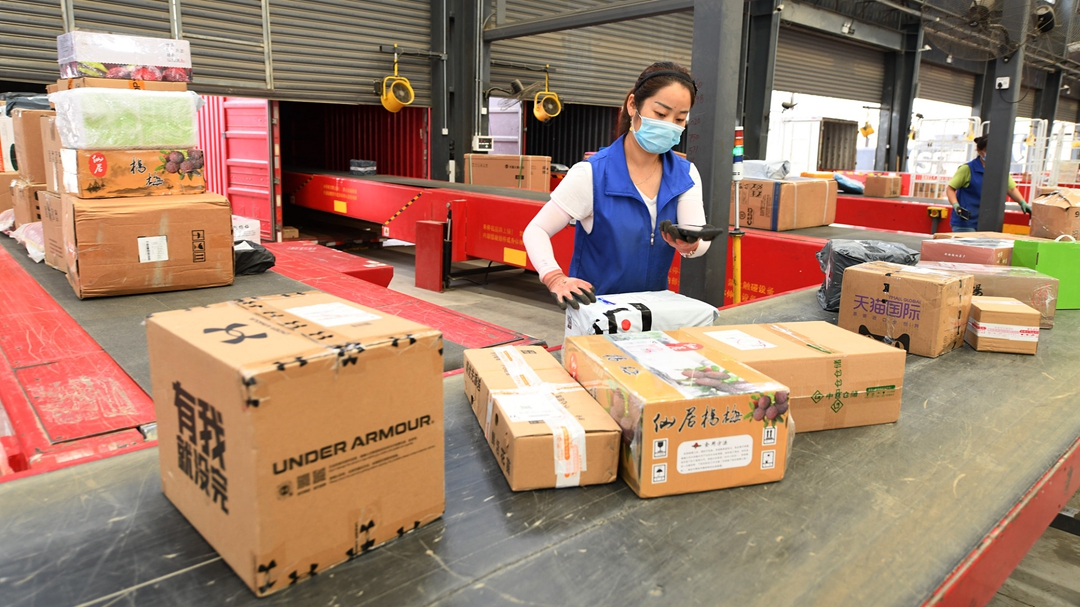
A courier assembly line in east China's Anhui province, June 19, 2020. /CFP
**Editor's note: **Shen Jianguang is vice president of JD.com and chief economist of JD Technology. The article reflects the author's opinions, and not necessarily the views of CGTN.
China's recovery in consumer spending is gaining momentum. In the fourth quarter of 2020, the monthly retail sales of consumer goods grew by between 4 and 5 percent year on year. Big data on online spending showed January 2021's recovery was in good shape. This reflects the effect of earlier policies to "protect jobs, basic livelihood, and market participants."
Looking forward to 2021, can consumption continue to recover? When will retail sales growth return to pre-pandemic levels? There are five major challenges ahead.
First, China still faces uncertainties related to the COVID-19 resurgence. This leads to a prolonged recovery of service consumption. Service consumption is obviously not as robust as spending on goods. As data from the National Bureau of Statistics (NBS) showed, catering revenue in December increased by only 0.4 percent year on year, 4.8 percentage points lower than headline retail sales. For 2020 as a whole, service spending as a percentage of total consumption declined. Expenditure on food, tobacco, alcohol and housing increased significantly compared to 2019, while service components such as transportation and communication, education, culture and entertainment, and medical care all declined by varying degrees. The lost share of service spending cannot be recovered. If the pandemic sees resurgence in many localities and control measures become normalized, service spending may experience a slower and more prolonged recovery as more uncertainties bite.
Second, online consumption has received a boost, but offline retail sales will continue to bear the brunt of the pandemic. According to NBS data, online retail sales of physical goods accounted for 24.9 percent of total retail sales in 2020, an increase of 4.2 percentage points from 2019. Behind that is the rapid increase in the level of online consumption and the rapid penetration of online offerings in lower-tier cities. Big data on online spending shows that from February to May 2020, when the pandemic was at its peak, year-on-year growth of active online consumers increased significantly, of which the growth of rural users was faster and more resilient. By contrast, offline retail consumption will remain under considerable challenge.
Third, an imbalanced recovery on the supply side could translate into income and demand gaps, as retail sales of smaller enterprises grew at a slower pace than that of larger enterprises. According to NBS data, retail sales of consumer goods of above-designated-size enterprises (i.e. larger enterprises) in 2020 declined by 1.9 percent, smaller than the 3.9 percent decline of total retail sales. We estimate that retail sales of below-designated-size enterprises (i.e. smaller enterprises) fell by 5.7 percent, meaning they were worse off compared to their larger counterparts. The shockwave of the pandemic has bankrupted some small- and medium-sized enterprises, leaving the market share to bigger market players. The impact of such supply-side imbalance cannot be underestimated. If it is transmitted into the income end and the demand side, the vigor of household spending could flag.
Fourth, discretionary spending across all tiers of cities is still declining as the pandemic makes a dent in "consumption upgrade." Big data on online spending shows that the pandemic has significantly impacted discretionary consumer spending across cities, with some posting negative growth despite rapid growth of consumer staples. Of course, the decline in consumer discretionary goods has narrowed as the economy improves. Data shows in first-, second- and fourth-tier cities, quarter-on-quarter decline in discretionary spending per capita in the fourth quarter of 2020 is more subdued than that in the previous quarter. However, with the recurrence of COVID-19 in the first quarter of 2021, the consumption upgrade may continue to slow down.
Fifth, low- and middle-income groups are vulnerable to risk, and their income as the key to consumption growth needs further boost. During the pandemic, low- and middle-income groups were hit disproportionately. Big data on online spending shows that in 2020, growth of per capita spending by high-income groups picked up compared to 2019, while that by other income groups have declined to varying degrees.
This reflects the underlying trend of widening income gap in China. NBS data show that the top 20 percent high-income people's per capita disposable income was 10 times that of those 20 percent people at the bottom of income rankings. The low-income groups are relatively more vulnerable to risks such. It means an underlying threat to consumption growth.
Beijing has been introducing a slew of measures to boost consumption, providing a solid foundation for recovery. Going forward, the following policy responses are advisable: expanding support via consumer coupons, preferably combined with the central bank digital currency pilot program; coordinating pandemic control and social economic development to avoid lockdowns that would affect circulation and consumption; boosting discretionary spending and low-tier markets by strengthening employment and income security for low- and middle-income groups; improving offerings of high-quality goods and online services and encouraging new types of consumption. All these should give full play to the advantages of China's super large economy, develop high-quality consumption and support the new "dual circulation" model of development.
 简体中文
简体中文

